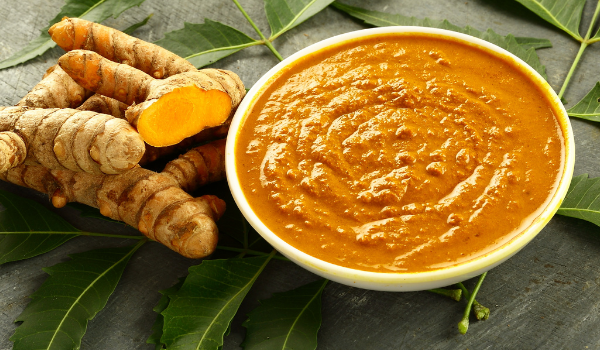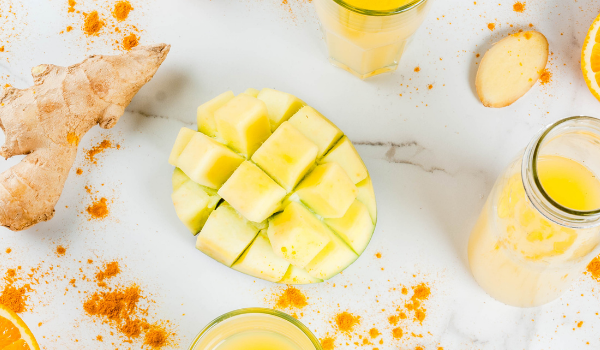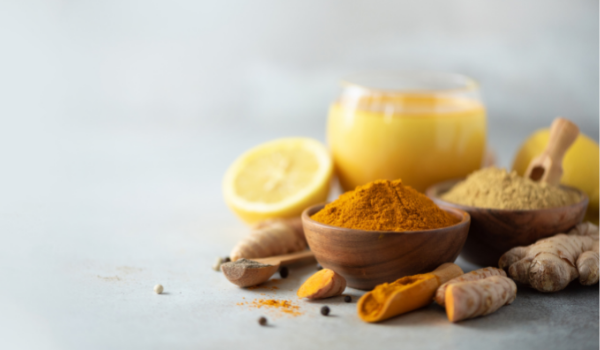Turmeric is a spice we have been hearing a lot about. Rightfully so, due to its potential health benefits.
The “golden spice” is actually from the root of a tall flowering plant (Curcuma longa), which is part of the ginger family. It is found in India and Southeast Asia. These two cultures, as well as others, have been using turmeric for about 4000 years in religious ceremonies, cooking, and in Ayurvedic medicine — a medical system used in India for thousands of years. It is also highly used in cooking in many other cultures.
In more modern times, we have been using it to help treat inflammatory conditions, skin disorders, digestive issues, liver conditions, as well as to help with wound healing. It is suggested to be an anti-inflammatory and anti-fungal agent, and an antioxidant.
Curcumin is the main active ingredient in turmeric, so ingesting turmeric powder, the most commonly found form of turmeric in grocery stores, could be beneficial to your health.
This all sounds great, doesn’t it? Unfortunately, there is an issue that lowers the health-boosting powers of this golden spice. Turmeric isn’t as bioavailable in your body when consumed alone. Our bodies metabolize curcumin very quickly, before it can be absorbed in the stomach and intestines, or processed by the liver. The good news is that studies have shown it isn’t toxic when used daily for most individuals. But always consult a physician or holistic practitioner before taking regularly. For anyone with anemia, being cautious using turmeric has been suggested, as studies suggest that turmeric, among other spices, may limit the absorption of iron in mice, though they need to do more studies on humans. Your best course of action would be to always check what foods and supplements will interfere with medication you are taking. For example, grapefruit can interact with many medications for the same reason turmeric does — they can both interfere with the enzymes that break down and metabolize medication.
In order for you to reap the benefits of turmeric, there are three things that help make turmeric more bioavailable to the body so we can absorb it and let it do its work:
- Mix with fat: curcumin’s low bioavailability is due to the fact that it is lipophilic (fat-soluble or attaches to fat), which means it has low solubility in water. Curcumin binds to fat, making it more easily absorbed by the GI tract. From there, it can be directly absorbed into the bloodstream through the lymphatic system, partially bypassing the liver. Mix it with coconut oil, olive oil, or avocado oil.
- Mix with black pepper: the compound found in black pepper is called piperine. Piperine is an inhibitor of drug metabolism, so you should consult your doctor before supplementing your diet with high doses of piperine. Your liver gets rid of foreign substances by making them water soluble so they can be more easily eliminated. The black pepper molecule piperine hinders that. Studies show it increases absorption of curcumin by up to 2000%. You will often find cold-pressed juices that have turmeric and black pepper in the ingredients. You only need a pinch of black pepper; you don’t need high doses of piperine to help with absorption.
- Cook with turmeric: many spices, not just turmeric, can be transformed using heat. The compounds they contain can become more activated and bioavailable. It has been suggested that exposing turmeric to heat, like in cooking, may increase curcumin’s solubility in water. It also may improve the antioxidant, anti-inflammatory, and anti-fungal properties. Turmeric is moderately sensitive to heat, so using it for cooking is a great way to get the benefits while enjoying the amazing flavour.
There are many ways to ingest turmeric that allow you to get maximum absorption and enjoy the taste and amazing visual effects it can give your meal with its vibrant colour.
Here are a few recipes you can start enjoying:
Turmeric paste

Ingredients:
- ¼ cup turmeric powder (organic and fair-trade)
- 1 tsp ground ginger
- 1 tsp cinnamon
- 1 tsp ground black pepper
- 2 tbsp coconut oil (you can use olive oil or avocado oil)
- 2 tbsp raw honey
- water
Directions:
- In a small mason jar or small bowl that has a lid, mix all the dry ingredients.
- Add coconut oil and honey. Mix as best you can, then slowly add water. Make sure you add a bit at a time, so you ensure it makes a thick paste. If you use olive or avocado oil over coconut, you will need less water.
- Use a bullet blender if you like or a whisk to make sure it is mixed well.
- Keep it in the fridge.
- Take a tbsp of the paste once a day.
Golden Milk

Ingredients:
- 1 ½ cups unsweetened almond milk or coconut milk
- 1 tsp turmeric powder
- ½ tsp cinnamon
- ½ tsp ginger
- Pinch of ground black pepper
- 1 tsp raw honey or 1 packet of stevia
Directions:
- Add all ingredients to a small pot and heat over medium heat.
- Whisking until it starts to boil and gets frothy.
- Pour into a mug and enjoy!
Mango, Pineapple, and Turmeric Smoothie
This is great post-workout due to turmeric’s anti-inflammatory properties to help with recovery.

Ingredients:
- 1 cup unsweetened coconut milk
- ½ cup frozen mango
- ½ cup frozen pineapple
- 1 tsp turmeric powder
- Pinch of black pepper
- ½ tsp ginger (optional)
- Water
- If you like it a bit sweeter, add a tsp of raw honey or stevia
Directions:
- Blend all the ingredients in a blender.
- Add water slowly to obtain desired thickness.
Yellow rice

There are different ways to cook yellow rice. An easy way is to sauté garlic and onions first, if you choose to use them. Add desired amount of rice to the same pan — jasmine or basmati — and turmeric powder (1–2 tsp) and mix well. Then add vegetable or chicken broth (use the amount needed to cook the amount of rice you’ve used). Increase heat until it boils. Once at boiling, reduce heat and cover. Cook until liquid is absorbed.
You can add vegetables of your choice and top with cilantro afterwards.
Healthy never tasted so good!
All of the recipes incorporate all three of the methods to improve the bioavailability of turmeric and allow you to enjoy it in its entirety. If you are taking a turmeric or curcumin supplement, take it with a meal that contains fat and black pepper. You should always consult your doctor before adding a supplement to your diet if you take regular medications or have medical conditions.
Turmeric’s health benefits are a win-win for our immune system; it may add an extra boost to our immunity and help us dodge illness or recovery faster. If you are experiencing gut issues like indigestion, gas and bloating, you may find some relief by taking turmeric. Always see your doctor before attempting to cure a problem: sometimes there are underlying issues that need to be addressed.
Sources:
Prasad, S., Tyagi, A. K., and Aggarwal, B. B. 2014. Recent Developments in Delivery, Bioavailability, Absorption and Metabolism of Curcumin: The Golden Pigment from Golden Spice. Cancer Research and Treatment, 46(1): 2–18. Url: doi: 10.4143/crt.2014.46.1.2 https://www.ncbi.nlm.nih.gov/pmc/articles/PMC3918523/ (accessed June 8, 2021).
Stohs, S. J., Chen, O., Ray S. D., Ji, J., Bucci, L. R., and Preuss, H. G. 2020. Highly Bioavailable Forms of Curcumin and Promising Avenues for Curcumin-Based Research and Application: A Review. Molecules, 25(6): 1397. Url: https://www.ncbi.nlm.nih.gov/pmc/articles/PMC7144558/ (accessed June 8, 2021).
Chainani-Wu, N. 2003. Safety and Anti-Inflammatory Activity of Curcumin: A Component of Turmeric (Curcuma longa). The Journal of Alternative and Complementary Medicine, 9(1):161–8. Url: https://pubmed.ncbi.nlm.nih.gov/12676044/ (accessed June 8, 2021).
Hewlings, S. J., and Kalman, D. S. 2017. Curcumin: A Review of Its’ Effects on Human Health. Foods, 6(10): 92. Url: https://www.ncbi.nlm.nih.gov/pmc/articles/PMC5664031/ (accessed June 9, 2021).
Smith, T. J., and Ashar, B. H. 2019. Iron Deficiency Anemia Due to High Dose Turmeric. Cureus, 11(1): e3858. Url: https://www.ncbi.nlm.nih.gov/pmc/articles/PMC6414192/ (accessed June 9, 2021).





